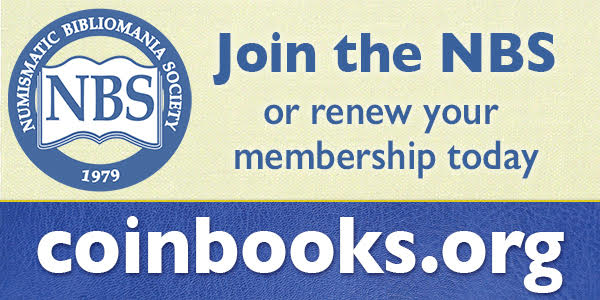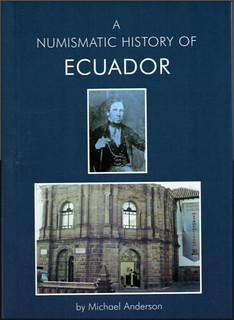
PREV ARTICLE
NEXT ARTICLE
FULL ISSUE
BOOK REVIEW: A NUMISMATIC HISTORY OF ECUADORAs part of his ECUADORIAN COINS - LIST #56, dealer Dale Seppa included this review of the 2001 book by Michael Anderson, A Numismatic History of Ecuador. We're republishing it here with permission. Thanks. -Editor
It is worth noting that an article published by David B. Fiero Ph.D., in World Coin News awhile back, is a truly excellent synthesis of the book, to include not only minting and monetary considerations, but also the economic, political and social implications for the pre-republican and early republican period in Ecuador. Fiero, one of only a very few in the United States with a doctorate in numismatics, wrote an outstanding essay that synthesizes the two hundred years of Ecuadorian numismatic history, covered in this book, in less than a dozen pages. That review was entitled; EYES WIDE OPEN, EARS WIDE SHUT: Ecuador's Struggle in the Nineteenth Century. Responsible "Minthood" or Quixotic "Enchantment"? Based on a pre-publication copy of the book, and his extensive knowledge, he more than adequately comments about the book, the mint, the country, the circumstances and the individuals involved. That said, I will give a very brief summary of what Anderson covers in A NUMISMATIC HISTORY OF ECUADOR. Starting with a brief Michener-like view of early Ecuador which also covers the various items used as a "store of wealth", Anderson proceeds to a brief yet detailed synthesis of colonial monetary affairs in the Royal Audiencia of Quito to include its interdependence on the Viceroyalties of Peru and New Granada. The footnotes by themselves often give information that modify widely accepted views; for example #32 on page 8: "Arnaldo J. Cunietti-Ferrando, Bischoff, op. cit., says... that the assayer Antonio Ovando was invented by Bartolome Arzans de Orsua y Vela in his HISTORIA DE LA VILLA IMPERIAL DE POTOSI and that the name is not confirmed by contemporary documents. Nevertheless, the name is quoted twice in the Cabildo of 30 December 1652 and three times in that of 12 June 1657." The Quito mint produced coinage from 1832 until 1863, yet was an incongruous institution meant for another time and place. Although the coinage was accepted throughout Ecuador and indeed throughout the world, it was essentially a local coinage, with the majority of the coins circulating in and around the remote city of Quito. The overall history of the mint can be conveyed in 3 words - "lack of funds". Throughout its 30 year life, the mint suffered from obsolete equipment which was often in a state of disrepair. The original machinery was scavenged from some unknown pre-republic source, in accordance with a Boliviarian decree of 1823, and spent many years in the house of a Colonel Klinger, who used it for "his own purposes", until he was forced to give part of it back to start the mint. The first acquisition of relatively modern equipment, other than a "new" coining press which might have arrived in early 1834 and a few odd items sporadically acquired, came when Guillermo Jameson was able to acquire some equipment confiscated from counterfeiters in Manabi in 1848. Ecuador had no mountain of silver nor any significant source of gold. Some of its first coins were struck with contributions from a few concerned citizens. The very first circulating coins were struck with silver "donated" by the churches. From that ignominious start, the mint limped along with silver and sometimes gold, imported at high cost or secured from small miners by charging them the equivalent of the Royal Fifth (20%) in return for minting their bullion. This actually constituted a barter system as opposed to a cash purchase system. That coins were produced at all, is a tribute to many; doctors, soldiers, a lady engraver and many humble, workingmen. The mint personnel were generally untrained, virtually bereft of financial support, and without proper machinery or materials. Regardless of difficulties, lack of experience, lack of support, lack even of a proper building, they struck beautiful, lasting coinage of the stated fineness, recognized throughout the world. There were problems in addition to those of production. Pre-decimal Ecuador was inundated with counterfeits. During many periods they were so ubiquitous that the government gave up the fight and allowed the counterfeits to circulate, with no penalty for the counterfeiters, even though the official penalty was death. The frequent schemes to confiscate and destroy counterfeits were usually halted, as soon it was realized that if all counterfeits were destroyed there would not be enough coinage for the people's daily necessities. Most counterfeits were eventually destroyed and the legitimate (as well as some of the better counterfeit) pre- decimal coins were not only used, but abused, for decades after issue, with none of them ever being retired for any reason, unless holed or if no vestige of the design remained. Over 90% of the small issues were worn blank and then used as bullion. In 1880 one foreigner turned in English banknotes for Ecuadorian coins and was not able to identify any of the coins because of excessive wear; he additionally reported that his change for purchases in stores, was often given to him in bread or eggs because there were no small coins available. About 225 pages of the total of some 400 pages covers the period mentioned above, as this is the most interesting period of Ecuadorian numismatic history. The balance of the book is devoted to the remaining periods up to the "dollarization" of the Sucre and includes the following chapters; Towards a Copper Coinage; The Introduction of the Sucre; The First Gold Standard; The Moratory Law; The Kemmerer Mission and the Second Gold Standard; From the Coinage Laws of 1937 to the Dollarization of the Sucre, as well as fifteen appendices, the extensive bibliography and a very detailed index. It is perhaps worth noting that the Ecuadorian "dollarized" coins of the year 2000 are illustrated as some numismatic publications have stated that there are no Ecuadorian coins dated later than 1997. While banknotes are not covered extensively, certain interesting facts emerge such as; "The issued specimen of Pick S111 dated 1 October 1868, described in Pick as `reported not confirmed', is illustrated by Estrada. It is signed by Clodoveo Cortes, and is in fact a provisional issue by the Banco del Ecuador before its own notes were printed." The book is extremely valuable for the serious historical researcher as well as the numismatist as dozens of documents have been translated to English, to include the regulations of the mint and most of the mint reports from 1836 through 1857, as well as actual correspondence from and to William Jameson, the Chief Assayer and later Director of the Mint. Anderson is a serious author and researcher with Bachelor's and Master's degrees from Cambridge University. He has been interested in coins from a very early age and has served on the Council of the British Numismatic Society and has been Secretary and President of the London Numismatic Club and Treasurer of the British Association of Numismatic Societies. He has contributed dozens of articles to the numismatic press, from "The Coins of the Grand Princes of Kiev" in Seaby's Coin and Medal Bulletin in 1963 to his last published article "Aristobulos of Chalcis and Salome" in Coins & Antiquities of April 1999. He joined the British Foreign and Colonial Office in 1958 and served as British Vice-Consul in Ecuador from 1965 to 1968, whence his interest in the coinage of Ecuador. He co-authored the second edition of "The Coins of Ecuador", published by Almanzar's Coins of the World in 1973. His own extensive collection of Ecuadorian coins, sold by Glendinings in February of 1977, is generally recognized as one of the most important reference works for the serious collector of Ecuadorian coins. Dale can be reached at daleseppa@gmail.com . -Editor For more information, or to order, see:
 Wayne Homren, Editor The Numismatic Bibliomania Society is a non-profit organization promoting numismatic literature. See our web site at coinbooks.org. To submit items for publication in The E-Sylum, write to the Editor at this address: whomren@gmail.com To subscribe go to: https://my.binhost.com/lists/listinfo/esylum All Rights Reserved. NBS Home Page Contact the NBS webmaster 
|
